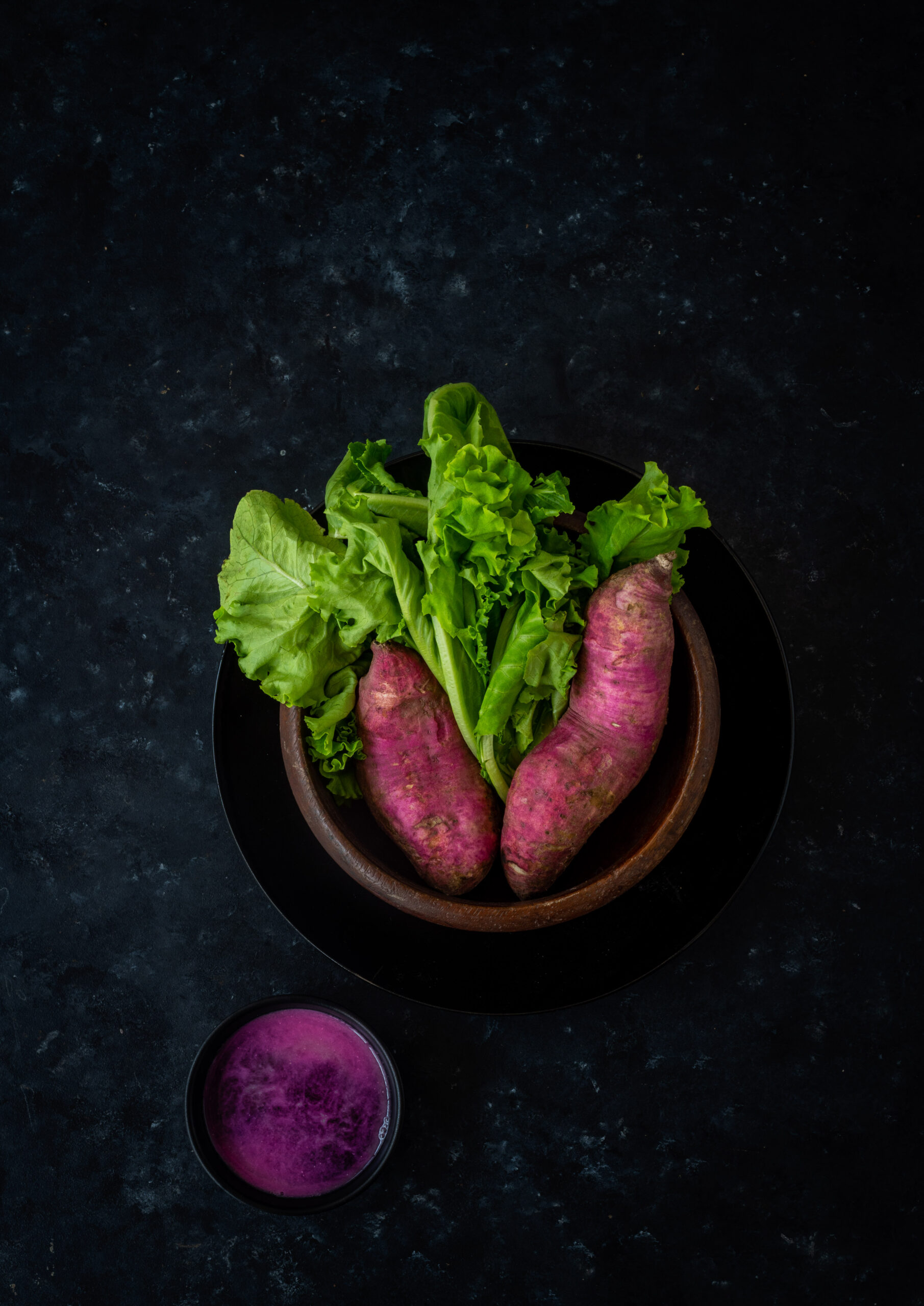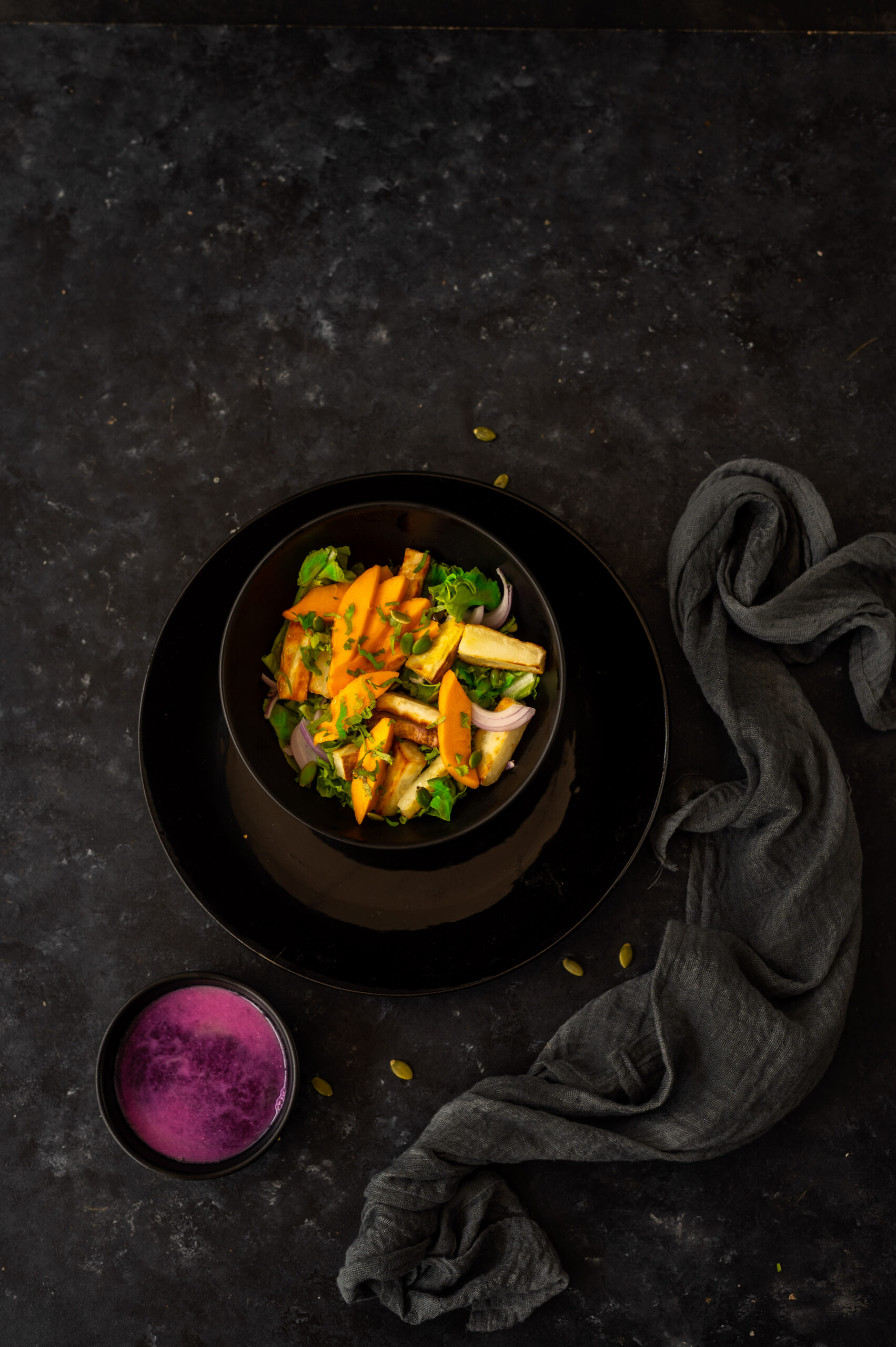The summer is here, and so are the sweet potatoes – and the mangoes! I couldn’t resist slicing some of these wonderful seasonal harvests up and putting them to delicious use in my kitchen. As you may know, we eat a lot of salads at home, and I’m always on a quest to add more variety and novelty to mine. The secret is in hitting on the right balance of flavours or textures, and pairing the dish with a dressing that uplifts it. I think I have a star in this one, and it’s delightful to me that it features one of the vegetables I have always enjoyed, alongside a fruit you just can’t go wrong with during an Indian summer.
I’ve spoken about mangoes plenty of times on this blog, so let me share my love for sweet potatoes as well.
The first way in which I enjoyed sweet potatoes was in a thick kheer or payasam that I used to have as a child. When they were in season and therefore plentiful, my mother would boil them, mash them and add milk. This would make for a very healthy dessert that required no further sweetening. She was an expert at such exquisitely simple milk-based desserts, and inspired me to create some of my own.

Certain memories come up when one contemplates any kind of familiar food. For me, the other important personal and cultural association that sweet potatoes evoke is that they are one of the ingredients that are permissible during the Faraali fasting that takes place in the month of Shravan, observed by Vaishnav Gujaratis. My mother maintained these fasts while we were growing up, and during those times she ate sweet potatoes frequently, and so did we.
Faraali is a relatively lenient type of fasting: it is not that consumption is not allowed, but that certain types of harvest are not permissible. Grains are taboo during this time, whereas tubers like sweet potatoes and yams form the bulk of the fasting menu.
Years later, through my Macrobiotics studies and my constant inquisitiveness about culinary science, I am able to understand and admire the beautiful logic of all fasting traditions, from Lent to Ramadan to Paryushan. I realise that Faraali must originally have been all about honouring the cycles of nature, avoiding certain types of harvest so as to allow the soil and the plants to replenish themselves during the rainy month of Shravan. It would also be the right time for the human body to purify itself with vegetables and fruits, as the weather would mean that people stepped out less and would also not be able to work in the fields. Fewer carbohydrates would be required, as less energy was required, so grains need not to be a part of the diet during that time. This is my perspective on the reasons behind this religious practice, and I often feel that when we think deeply about rituals, many of them will have a practical function behind them. Our ancestors were far more in sync with nature than we are, and had the wisdom to develop daily and seasonal routines that respected and kept this balance.
So for us today, as modern human beings with eclectic palates, one way to stay in sync is to accept that heavy lunches in the summer time make us more lethargic, and can diminish our productivity over the rest of the day. Salads cut out the heavy carb load of rice and grains, while also being filling, delicious, nourishing – and visually vibrant, which improves the mood and whets the appetite. If you’re a fan of this food category, be sure to explore my archives, where I’ve shared many of the tried-and-true salads that are super hits at home: this one where the passion fruit dressing is the star, another season-suitable mango salad, a nutritious millet salad, and a few dishes you may not have thought of as salads but really are, like peach salsa, sundal and green moong bhel. Another health-boosting eating habit is to regard a salad not as an appetiser or an accompaniment, but as a meal-in-a-bowl. It’s really just about portions.
Coming specifically to this summery sweet potato and mango salad, I am often a bit suspicious of the unusual sweetness of the sweet potato chips that many restaurants serve, and I prefer making them myself. The technique is very easy, as you’ll see below. You can substitute the sweet potatoes for yams, and use the same thin-sliced technique to fry them. These crispy sweet potatoes are what I use in this salad. If you prefer not to fry them at all, you can have them steamed and sliced. It all depends on the textures you’re building the salad with, and any health or taste preferences that you may have.
Seasonal Sweet Potato And Mango Salad
(Yield: 1 bowl)
½ cup sliced sweet potato
½ cup sliced ripe sweet mango
2 cups lettuce
½ onion
2 tablespoons coriander leaves
1 teaspoon olive oil
1 tablespoon sunflower seeds
Dressing:
Salt to taste
1 tablespoon honey
2 tablespoons lemon juice
4 tablespoons pomegranate juice
A pinch of black pepper
1 tablespoon olive oil
In a bowl, add all the dressing ingredients together. Store this in the fridge.
Heat a pan and add the oil. Once the oil has heated, add the sliced sweet potato. Make sure the sweet potato is sliced thin so that it can cook faster. Cover with a lid and allow to cook for a few minutes on a low flame.
Then, remove the lid and increase the flame to medium. Allow the slices to turn crisp. Flip them to ensure that both sides are well done. Once they are fried, set them aside.
Prepare the salad by putting the sliced onion and torn lettuce into a bowl. Add the fried sweet potato crisps and the fresh mango slices on top. Add the dressing, garnish with coriander leaves, and mix gently. Allow to cool for some time, and serve.
I hope you’ll enjoy the mix of crispiness and sweetness in this simple yet satisfying sweet potato and mango salad. It’s just perfect for this hot weather, and keeps you light on your feet after the meal. Speaking of the summer, since we are in mango season here in South India, you can expect next weekend’s post to celebrate the fruit. In the meanwhile, maybe you’ll want to check out the many ways the mango has starred in my recipes over the years?


